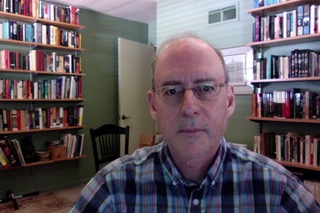by Jeffrey Greene
Dr. Liebkindt was puttering in his backyard garden when the phone that he used for his practice took a message. He cut a last length of twine and secured a sagging tomato vine to the wire of its cage, then pushed himself to his feet with a grunt of pain and headed for the house, looking sourly at the overcast sky, which had falsely promised rain all week and not given a drop. He wrote a note reminding himself to turn on the drip hose after sunset and left it on the cutting board in the kitchen, where he couldn’t fail to see it. He listened to the message, then dialed the number, and Sheila Van Ackerman quickly answered in her usual tone of mingled truculence and panic. He spoke reassuringly, telling her to expect him within the hour, traffic permitting.
Although he still had an office in his house and saw a few patients, his general surgery practice had shifted almost completely to home visits in recent years. So many people preferred being treated at home these days, with the rampant and often justified fear of air-borne diseases and post-op infections, that at a time in his career when most of his colleagues were winding down and working on their golf games, his practice was thriving. After washing up and donning his worn gray suit, he went to his office, gathered his surgical instruments and sterilized them, then, using sterilized tongs, placed them carefully in his medical bag. Filling the bottom of an ice chest with a bag of ice from the deep freeze in his basement, he placed it in the trunk of his old diesel Mercedes, then backed the big car out into the street. The lush green canopy of his neighborhood in early July, which felt more like a climax forest of maple, cherry, tulip poplar, and oak than a Fifties-era redbrick suburb, always soothed him.
The drive around the beltway and across the American Legion Bridge into Virginia had its usual infuriating delays, and it was after four by the time he arrived at the gated community where the Van Ackermans lived. He had briefly consulted his notes before leaving the house, and verified that this was his seventh and, he hoped, last visit to the Van Ackerman home. The boxy, oversized houses were built on absurdly small plots and differed so slightly from one another that it was hard to tell one street from the other, much less the houses. And yet it seemed to him as he parked in the massive driveway leading to a three-car garage that the other houses were visibly shrinking back from the Van Ackerman home, as if from a pesthouse. As was often the case with these affluent subdivisions built during the real estate boom, the streets were all but deserted, the yards occupied only by efficient teams of lawn care professionals, their deafening, diurnal presence lending the neighborhood a brief illusion of vitality.
He was greeted at the door by a sweaty Harold Van Ackerman, wearing a patriotically colored jogging outfit and expensive running shoes. He was a tax lawyer with one of the big firms in northern Virginia, a large, awkward, hirsute man with dyed hair, moist, evasive eyes and too much weight around the middle. Dr. Liebkindt had treated him surgically a decade ago for an inguinal hernia, and more recently for a bunion. Van Ackerman led him into the kitchen, where he was offered—and, as always, refused—a cold drink. His host shrugged with exaggerated indifference and poured himself a large lemonade from a carton, which he drained in one go, loudly smacking his lips.
“Hot day,” he said. “Just ran three miles.”
“Good for you, Harold,” Dr. Liebkindt said. “How’s that toe doing?”
“Stiff. Throbs at night, sometimes,” he said, with a nervous chuff of laughter. “But it works, more or less. No blame in your direction, doctor.”
“I know that,” he replied, smiling. “Surgery can be disappointing. The hundred percent fix doesn’t usually happen, in my experience. But we did what we could.” He was distracted by what sounded like half a dozen televisions going all over the house, tuned to different channels, which in this vast and seemingly unused stainless-steel kitchen, sounded to him like the inexorable approach of chaos. He could hardly wait to get out of here.
“Well, I suppose we should see about Trish,” he said.
“No reason to put it off, I guess,” Van Ackerman said. “Sheila’s in bed with a migraine. This whole thing’s been hell on her.”
“Of course it has,” Dr. Liebkindt said, playing his part. Sheila had no stomach for these treatments. What parent would? “But I think we’re almost out of the woods now,” he said. “Trish has a good chance for a full recovery.”
“I’m still having trouble believing that,” Van Ackerman said, leading the way to his daughter’s bedroom upstairs. “Much as I want to.”
“The treatment is radical, no argument,” Liebkindt said. “But so is the disease. The chemo, radiation and immunotherapy approaches simply don’t work with these new cancers. We’ve had to improvise.”
An odor, so faint as to be almost imaginary at the foot of the stairs, began to assert itself as they climbed, and by the time Van Ackerman opened the door—after an absurdly unnecessary knock—the stink, which his host had likened to a gas mask stuffed with Limburger cheese, was overwhelming. Used to it by now, though his stomach still revolted, Dr. Liebkindt approached the railed bed.
Patricia Van Ackerman, a tall, previously healthy and athletic seventeen year-old, the oldest of four children, wearing a clean hospital gown, sat impassively on the green quilt bedspread, propped up by several pillows, her hands, curled and twitching slightly, resting palms up on her lap, her long, pale, unshaven legs stretched out full length on the bed. The muscles had atrophied during her long illness, and probably wouldn’t support her weight, even though it had dropped to under ninety pounds. Her Cheyne-Stokes respiration, typical in these patients, made a wet, hissing sound around the feeding tube taped to the black, calcified lips.
Taking a measuring tape and a small notepad from his coat pocket, Dr. Liebkindt silently measured the length and width of the noticeably smaller mass that, before the onset of the disease, had been the girl’s head, then jotted down the results. It was still larger than her original head size, but now only by a centimeter or so. For more than a year now it had been an independently functioning neo-tumor, a complex, amalgamated mass of osteosarcoma, chondrosarcoma, and leiomyosarcoma, a sort of cooperating community of cancers involving, respectively, the bones, connective tissue and muscles of her head, face, and the upper half of her neck.
What had been the girl’s straight brown hair was now a hard, bony mass that grew in irregular spikes, bumps and swirls from the scalp, and her eyes were lost under an inch of dense, horny tissue extending down from the brow ridges and growing into the cheekbones. The regenerated brain and blood vessels, as was becoming the rule in these still-rare and poorly understood cases, remained more or less intact, although the flow of blood was somewhat reduced and the brain mercifully remained comatose, which, with each successive generation of the neo-tumor, gradually climbed back to the level just below that of the deep sleep that Trish was in now. This was the first neo-tumor he had ever treated, but if the published papers he’d read were any guide, she would begin to wake up after the regeneration following today’s treatment.
“You notice how much smaller it is this time,” Dr. Liebkindt said over his shoulder to Van Ackerman, who had sagged against his daughter’s dresser, a handkerchief held over his mouth. “That’s a very good sign.”
“Take your word for it.”
Dr. Liebkindt took her blood pressure and listened to her heart, then removed a folded plastic sheet from his bag and spread it on the bare, pinewood floor. Lifting what looked like an adult-sized high chair, with restraints for the chest, wrists, and ankles, in addition to a plastic feeding tray, he positioned it in the center of the sheet. He carefully withdrew the feeding tube and lowered the bed rail, then nodded to Van Ackerman, and the two men gently lifted Trish and carried her to the chair. After strapping her in, Dr. Liebkindt took from his bag a bottle of betadine, a box of cotton swabs and an extra-large, sealable plastic freezer bag, which he placed on the floor near the plastic mat.
“I’m leaving now,” Van Ackerman said. “Call me if you need me.”
“Will do,” Liebkindt said, hardly glancing up as the door closed behind him.
He donned a surgical smock, cap, and mask, then went into Trish’s bathroom—all four children had their own private baths—and thoroughly scrubbed his hands. Swabbing the girl’s neck with betadine, he then donned surgical gloves and took out his portable, stainless steel surgical shears, unfolded and locked them into place. Positioning himself directly behind the patient, he carefully fitted the blades as close to the borderline of the tumor as he could sight it, which was about two inches above the base of the neck, below which the skin was unblemished.
“All right, Trish, here we go,” he whispered in her ear, which resembled a barnacled, blackish-gray and much-eroded sea shell, encased, as the entire head/tumor was, in a sticky iridescent membrane, the source of the foul odor. “Let’s hope to God this is the last one.” He took a deep breath, then drove his hands together with all his strength. The head tumor tumbled forward, bounced on the tray of the chair, then fell onto the plastic and rolled to a stop at the very edge of the sheet. The arterial blood spurts were shockingly brief, lasting only seconds before the neoplasmic tissue fibers grew with incredible speed across the severed veins and arteries and staunched the flow. This phenomenon had been repeatedly observed by Dr. Fenrick, the developer of the excision treatment for neo-tumors of the head and face, who believed—correctly, as it turned out—that the new cancers were, as he put it in his landmark paper first published in The Lancet, “self-interested in preserving the life of the host.” The patient’s fingers and toes trembled, but the reflexive jerking of the limbs was prevented by the straps. Picking up the excised head tumor, he placed it in the large freezer bag and carefully sealed it.
Although he could have used Van Ackerman’s help to clean up, he knew he was on his own now. Unstrapping Trish from the chair and lifting her—it always surprised him how much lighter she was after the excision—he carried her into the bathroom, where he used the hand-held shower nozzle to rinse off the blood and tiny splinters of bone and spinal tissue. Finding a clean gown in the dresser, he changed her, with some difficulty—at sixty-six, his back and knees were pretty much shot—then carried her to her bed, placed her back against the pillows and started an IV of saline solution. From force of habit, he applied betadine directly to the wound, knowing how resistant these tumors were to infections of any kind.
The feeding tube couldn’t be re-started until after the normal head grew back in, which, even though driven by the dying embers of the tumor’s strength, had been observed to regenerate in as little as six weeks. In the meantime, a vitamin supplement administered in the IV solution would keep her alive. His surgical smock went into his medical bag, then he washed up, cleaned and put away the tools of his trade, and lastly, rinsed off the plastic sheet and wrapped it around the freezer bag, in order to spare the parents the sight of it. Borrowing one of Trish’s long-unused brushes to tidy up his startled bush of gray hair, he opened the door and descended the stairs.
Van Ackerman and his wife were having drinks in their massive, high-ceilinged living room, Sheila having apparently made a swift recovery from her migraine. She stood up as he entered, stuffed into a pair of low-cut jeans designed for a teenager, her surgically tucked belly just covered by a rhinestone-studded, sleeveless t-shirt. Dyed hair and facelifts ran in the family, but even with her face cosmetically stretched into a permanent expression of surprise, the pain in her eyes was terrible to see.
“Dr. Liebkindt, what the fucking hell…!” she almost shouted, teetering on her high heels, her drink sloshing.
“It’s all right, Sheila,” he said. “The procedure went smoothly. Trish is a strong girl, like her mother. We’ll know very soon if this is the last treatment.”
“What do you mean, if it’s the last? You’re telling me you’re not sure!? Jesus Christ, I can’t go through this again. You know it’ll kill me.”
“I know, Sheila, and I’m sorry as hell about it. This is a tough disease, and it doesn’t go quietly. I think we’ve won the war, but I won’t be completely sure until it regenerates.”
“And what happens then?” Harold asked. “What will she be like?”
“If there are no signs of fibrous tissue, and she’s conscious, then the real work begins. As I explained at the beginning, there won’t be any memory of what she’s been through, not the slightest trace. We usually tell patients like Trish that they’ve just come out of a deep coma, which is factually true. She doesn’t need to know about the neo-tumor, unless you choose to tell her. That’s the upside: the amnesia. The downside? She’ll be a blank slate. There’s no conservation of memories, experiences, learning or language in a regenerated brain, but accelerated learning programs can get her back to speed in only a few years. She’ll be a little behind the curve of her peers, but so what? You’ll have your daughter back. Neo-tumors almost never recur. All in all, I’d say the prognosis for Trish is excellent.”
Sheila was crying now. Harold took her drink out of her hand and helped her back to her chair.
“We’re grateful for all you’ve done, doctor,” he said. “Can we offer you a drink for the road?”
He shook his head. “I’d like to, Harold, but duty calls. You still have a home visit nurse, correct? Coming later this evening?”
“That’s right.”
“Ask her to change the IV, and clean the wound again. Have her call me if anything unusual crops up. And I’m sure I don’t need to tell you to stay out of Trish’s room for a while. Risk of infection is low, but still…”
“You don’t need to tell us,” Van Ackerman said, grimacing. “Wild horses couldn’t… Anyway, thanks again.”
“No problem. I’ll be back to see her in three weeks. Goodbye.”
Outside, Dr. Liebkindt opened the trunk of his car and placed the bagged tumor in the ice chest, then backed out and headed home. Traffic was even worse than expected, which gave him plenty of time to dictate his notes, and it was after six when he finally pulled into his garage. He carried his bag to the basement and dumped the dirty smock into the washing machine, then went back to the garage for the ice chest. He reached down into the compartment of the deep freeze he reserved for specimens and pulled out six bags, which he lined up on the long counter next to the freezer, in chronological order, adding the latest specimen at the end.
The difference in size between Trish Tumor #1, as he had labeled the bag, and Trish Tumor #7 was striking, on the order of five inches in diameter, the size steadily decreasing with each excision, the last one only slighter larger than Trish’s head prior to the onset of the disease. He also noted that with each incarnation of the tumor, the girl’s original features were slightly more distinct. As he had done every time, he took several pictures of the lined-up tumors, then replaced them in the freezer, making a label for the last bag before placing it on top of the others.
He’d been toying with the idea of writing a paper on the Van Ackerman case, though he doubted he’d ever get around to it. His son, however, was a cancer researcher at NIH, and had asked him to donate the specimens to the hospital as soon as the case was resolved. There was a lot of excitement in cancer research these days over the mysterious regenerative capacity of the neo-tumors, and there were high hopes in his son’s circle of eventually harnessing them to regrow lost body parts, even, some believed, to grow a whole new body when the old one wore out. Though skeptical that these rogue cancers could ever be tamed and harnessed to any useful degree, much less proffering dubious immortality, Liebkindt wished his son success, and was happy for the chance to contribute in a small way.
He went upstairs and changed back into his old clothes, then found the note reminding himself to turn on the drip hose. He would do that later, after the sun went down. In the meantime, he made himself a whisky and soda and drank it on the screened-in porch, where he had a splendid view of one his favorite places: his own backyard. With the smell of his neighbor’s freshly mowed grass wafting across the high fence, he sipped his drink and thought about Trish Van Ackerman, his late wife, his promising crop of heirloom tomatoes, and his son, the researcher.
 Jeffrey Greene was born in Michigan, raised in Florida, and currently lives in Bethesda, Maryland. He has been writing and publishing short stories and the occasional novella since the 1980s. Some of the publications in which his stories have appeared are the North American Review, Tomorrow Speculative Fiction, Oasis, Reactor Magazine, Potomac Review, decomP Magazine, Zahir Speculative Fiction, and most recently, Bewildering Stories.
Jeffrey Greene was born in Michigan, raised in Florida, and currently lives in Bethesda, Maryland. He has been writing and publishing short stories and the occasional novella since the 1980s. Some of the publications in which his stories have appeared are the North American Review, Tomorrow Speculative Fiction, Oasis, Reactor Magazine, Potomac Review, decomP Magazine, Zahir Speculative Fiction, and most recently, Bewildering Stories.
His short story, “The Blind Gambler,” was included in the anthology, “100% Pure Florida Fiction,” in 2000, published by the University of Florida. He has self-published two collections of short stories: Stories From the Cold Room, and The Iron Desert and Other Stories.
![]()






